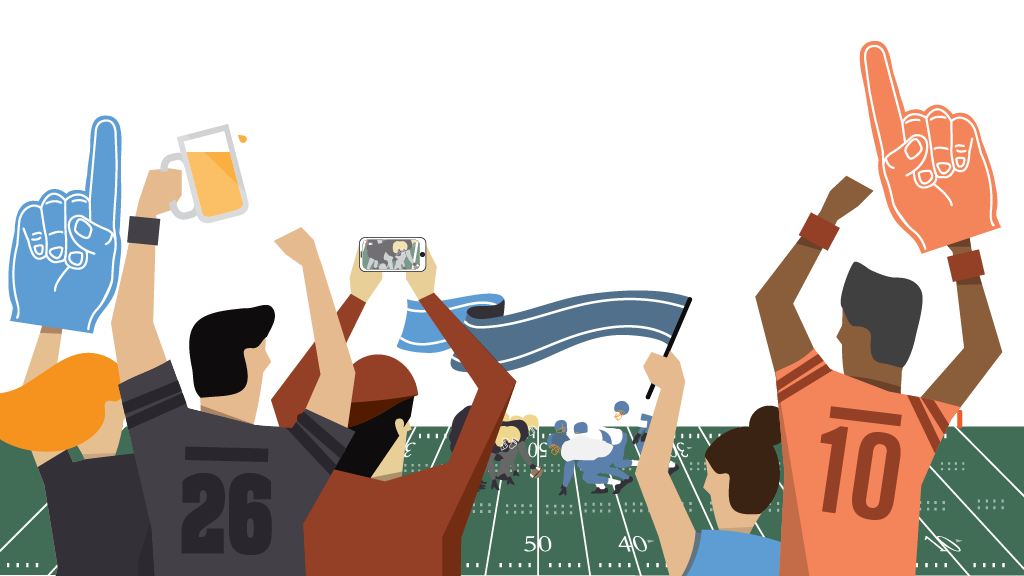Is winning the only factor that significantly affects sports brand engagement?
#Winning the Fan Engagement Game
What We Did
Our survey asked fans what factors might make them more or less of a fan, from building a new stadium to more community involvement, and also asked them to tell us how long they would tolerate chronic losing and still remain a fan. We analyzed this data against Emory University’s 2014 rankings, based on a statistical model developed by two college professors that quantitatively measures the economic impact of a loyal and active fan base, which we saw as a proxy for fan engagement. We also looked at a composite index of NFL stadium rankings and the 32 NFL franchises’ win-loss records since 2000. This data helped us understand what factors besides winning allow NFL franchises to maintain or increase brand engagement.
The Context
In spite of these positives, the NFL is facing a number of thorny issues, including decreased game-day presence, troubling findings regarding player safety, and periodic public outcry over players’ off-field behavior. To maintain and grow their enviable competitive position and expand revenue, NFL franchises must capitalize on factors other than winning to heighten fan engagement. For winning franchises, there’s an opportunity to build on the increased loyalty and money that good performance generates; for losing franchises, there’s an opportunity to boost revenue streams and in turn, they hope, revive winning ways.
The Results
Our side-by-side analysis of Emory University’s rankings, win-loss records from 2000–2015, and a composite index of NFL stadium rankings shows that teams with highly ranked stadiums have higher fan affinity than teams with poorly ranked stadiums, and that teams with better-ranked stadiums also enjoy better winning percentages, suggesting a positive cycle of stadium experience, results, and engagement.
We love you the way you are. Great sports brands invoke a sense of tradition and closely align with their home city’s civic identity. Gensler’s 2013 Brand Engagement Survey revealed that sports brand fans value tradition and stability far more than innovation and change. Franchises that underestimate the power of these preferences risk alienating fans.
Relocating a team to another city, changing its name, and changing the logo and/or the team’s colors were the three factors survey respondents said were most likely to make them less of a fan. Moving away from the current site, even for a better facility, was also a detractor. This is further proof that the stability of a team’s brand is paramount to maintaining fan engagement.
Higher affinity/engagement correlates with a lower tolerance for losing. Despite their preference for legacy and stability, highly engaged fans expect results and are less likely to be patient in the face of chronic losing. When asked how long they would tolerate losing, fans of teams high on Emory University’s rankings expressed less of a willingness to be patient than fans of teams with lower scores. Two exceptions to this finding were the Dallas Cowboys and New York Jets, with mediocre 15-year records and highly acclaimed stadiums.
What This Means
Use the stadium to energize your fan base. #Winning franchises tend to have great stadiums. Great stadiums function as important pieces of civic architecture, connect franchises and their brands to the communities around them, and give viewers at home something to be proud of. They fuel a sense of being a #winning organization and have a significant capacity to boost overall fan engagement. That energy and pride remain long after the final whistle sounds, and so franchises cannot underestimate the importance of presenting invigorating game-day experiences. Whether they can translate #winning into winning the Super Bowl? That remains to be seen.
Engage fans outside the stadium walls. While a great game-day experience goes a long way toward boosting overall fan engagement, franchises must also viscerally connect with the fans who watch from home. Gensler’s 2013 U.S. Brand Engagement Survey revealed that a majority of fans prefer online engagement with their favorite team to in-person engagement (likely related to our survey respondents’ saying lower ticket prices would make them bigger fans). Our more recent NFL-focused survey reinforced that importance of engaging with fans outside the stadium walls: respondents identified increased community involvement as one of the factors that would make them more of a fan.
What’s Next?
Through additional research, we will seek to conclusively determine how stadium design influences actual on-field athlete and team performance. These inquiries and the results they surface will continue to shape our approach to sports brand strategy and stadium facility design.
Learn More
Team
Kate Kirkpatrick, Evan Hathaway, Tom Milavec
Year Completed
2016
Comments or ideas for further questions we should investigate?
